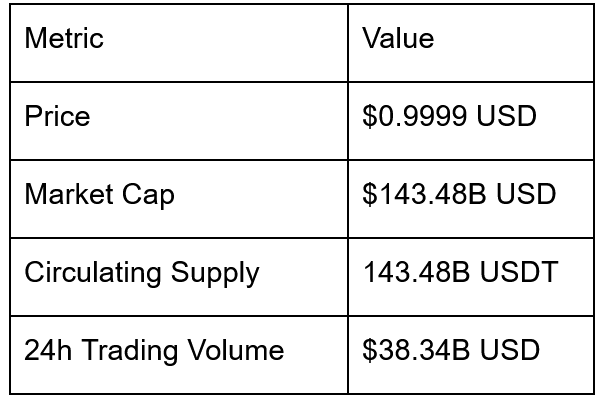Significado do USDT: Análise aprofundada da definição da stablecoin e perspectivas futuras
1. Fundo do Projeto USDT
A Tether foi fundada em 2014, originalmente conhecida como Realcoin, e posteriormente renomeada como Tether, co-fundada por Craig Sellars, Reeve Collins e Brock Pierce. A intenção original da Tether era criar uma moeda digital atrelada a uma moeda fiduciária para reduzir a volatilidade do mercado de criptomoedas.
Em 2014, a Tether lançou a primeira stablecoin USDT, emitida na camada Omni baseada no Bitcoin. Inicialmente, o USDT foi emitido através da exchange Bitfinex, que é a empresa irmã da Tether. Com o tempo, o USDT migrou gradualmente para outras plataformas de blockchain, como Ethereum, Tron e Algorand, para melhorar a velocidade de transação e reduzir custos. Em 2025, o USDT é mais ativo no Tron e Ethereum.
A Tether afirma que cada USDT é lastreado por uma quantidade equivalente de dólares americanos ou outros ativos para garantir sua estabilidade. A empresa regularmente divulga relatórios de reservas para comprovar a autenticidade e transparência de seus ativos. No entanto, a Tether enfrentou controvérsias e escrutínio regulatório, especialmente durante a investigação de 2019 pelo Escritório do Procurador-Geral de Nova York, onde foi acusada de falta de transparência e conduta potencialmente imprópria. No entanto, a Tether gradualmente restaurou a confiança do mercado, melhorando seus mecanismos de relatórios e auditoria.
2. Princípios Técnicos USDT
USDT, como uma stablecoin, seus princípios técnicos incluem principalmente os seguintes aspectos:
- Mecanismo de ancoragem: O valor do USDT é mantido estável ao fixá-lo ao dólar dos EUA numa proporção de 1:1. A Tether afirma que, para cada USDT emitido, uma quantidade equivalente de dólares americanos ou outros ativos de valor igual (como títulos do governo de curto prazo, equivalentes em dinheiro) são mantidos em uma conta bancária.
- Plataformas blockchain: USDT foi inicialmente emitido na camada Omni do Bitcoin e posteriormente migrado para plataformas como Ethereum, Tron e Algorand. Diferentes plataformas oferecem diferentes vantagens, como suporte a contratos inteligentes no Ethereum e alta taxa de transferência no Tron.
- Emissão e resgate: Os usuários podem converter dólares americanos em USDT através da empresa Tether ou parceiros (como exchanges) e vice-versa. Esse mecanismo garante a liquidez e estabilidade de valor do USDT.
- Transparência e Auditoria: A Tether publica regularmente relatórios de reserva auditados por empresas de auditoria de terceiros, como a BDO, para comprovar a autenticidade e suficiência de seus ativos. Até 2025, os relatórios de reserva da Tether se tornaram um padrão da indústria, demonstrando seu compromisso com a transparência.
3. Economia do Token USDT
O modelo de tokenomics do USDT é relativamente simples, mas ainda inclui os seguintes pontos-chave:
- Emissão Total
A Tether emite USDT com base na demanda de mercado e na disponibilidade de ativos de reserva, sem um limite superior fixo. Em outras palavras, à medida que a demanda no mercado de criptomoedas cresce, a Tether pode aumentar ou resgatar dinamicamente USDT para manter uma relação de 1:1 com o dólar dos EUA e outros equivalentes. - Ativos de Reserva
De acordo com a Attestation do Tether do quarto trimestre de 2024, os ativos totais de reserva do Tether são aproximadamente 143 bilhões de USD, com mais de 79% sendo em títulos do Tesouro dos EUA. Essas reservas também incluem outros títulos do governo, dinheiro, equivalentes de caixa e outros ativos seguros. O Tether alcançou um lucro líquido de cerca de 13 bilhões de USD em 2024 e alcançou o maior valor histórico em participações do Tesouro dos EUA. Os funcionários do Tether afirmam que o tamanho das reservas é suficiente para apoiar a quantidade de USDT emitida e regularmente comprovarão a autenticidade e liquidez dos ativos de reserva por meio de auditorias ou relatórios de atestação. - Estrutura de Taxas
As taxas de transação para USDT variam em diferentes blockchains, com redes emissores comuns incluindo Ethereum, Tron, e assim por diante. No geral, as taxas de transação para USDT são relativamente baixas, tornando-o adequado para negociações frequentes ou remessas transfronteiriças. Ao mesmo tempo, as exchanges (como a Gate.com) podem cobrar certas taxas para o depósito, saque e negociação de USDT, sujeitas às políticas específicas da plataforma. - Modelo de Governança
Tether é gerenciado por sua equipe fundadora e principais investidores, sem fornecer um mecanismo de governança pública de detentores de tokens. A empresa fornecerá transparência à comunidade e às agências reguladoras por meio de anúncios oficiais, provas de reservas, auditorias regulares, etc., mas o poder de tomada de decisão e a direção operacional são principalmente controlados internamente pela Tether.
A tabela abaixo resume a composição dos ativos de reserva da Tether com base em informações públicas (dados até 31 de dezembro de 2024, os números reais podem ser ajustados):


Fonte:Atestado Tether Q4 2024
Em geral, o USDT depende de uma grande reserva de ativos e de um mecanismo flexível de emissão e resgate para manter a estabilidade de valor e aumenta a confiança do mercado ao fortalecer continuamente os processos de conformidade e auditoria. Em 24 de março de 2025, os dados de mercado mostram ainda mais que a circulação e o volume de negociação do USDT continuam a aumentar, solidificando a posição de liderança da Tether na corrida das moedas estáveis.
4. Análise do Mercado USDT
Em 24 de março de 2025, o valor de mercado do USDT é de aproximadamente 14,348 bilhões de USD, classificando-se em terceiro lugar entre todas as criptomoedas. Como a maior stablecoin em capitalização de mercado, a circulação e o volume de negociação do USDT ainda lideram outras stablecoins (como USDC, BUSD, etc.), desempenhando um papel importante como âncora de valor no mercado de criptomoedas. Com sua característica de estar vinculado 1:1 ao dólar dos EUA, o USDT é comumente usado para proteger o alto risco de volatilidade dos ativos criptográficos, tornando-se um dos meios de precificação e negociação mais populares em grandes exchanges (incluindo Gate.com).
A tabela abaixo mostra os dados de mercado-chave do USDT (a partir de 24 de março de 2025):


Fonte:CoinMarketCap
A partir desta tabela, pode-se ver que o preço do USDT costuma ficar em torno de $1.00 USD, refletindo sua característica principal como uma stablecoin. No entanto, em condições de mercado extremas, o USDT também pode se desviar ligeiramente da taxa de 1:1. De acordo com as previsões atuais do modelo de IA, é provável que o preço do USDT permaneça em torno de $1.00 com flutuações relativamente pequenas. Seu maior valor para os investidores está em fornecer uma alternativa estável de moeda fiduciária para negociação e conversão de ativos, enquanto reduz os riscos de mercado associados à alta volatilidade das criptomoedas.
Vale ressaltar que, de acordo com dados históricos, o preço histórico mais alto do USDT atingiu cerca de $1.22 em 25 de fevereiro de 2015, e o preço mais baixo caiu para cerca de $0.5683 em 1 de março de 2015. Atualmente, com a melhoria contínua da prova de reserva e do mecanismo de auditoria, o USDT ganhou alta credibilidade na garantia da estabilidade de valor e liquidez, desempenhando assim um papel indispensável no ecossistema de criptomoedas.
5. Notícias recentes sobre USDT e dinâmica de mercado
- No início de 2025, a Tether lançou seus documentos comprovativos para o quarto trimestre de 2024, mostrando um lucro líquido de $13 bilhões para o ano de 2024, o mais alto da história. Ao mesmo tempo, os ativos da Tether em títulos do Tesouro dos EUA atingiram o valor histórico de $113 bilhões, consolidando ainda mais sua posição como a maior emissora de stablecoins do mundo.
- Em 7 de março, a Tether anunciou que auxiliou o Serviço Secreto dos EUA a congelar $23 milhões de fundos ilegais relacionados à exchange sancionada Garantex. Isso demonstra o papel proativo da Tether no combate aos crimes financeiros.
- Em 3 de março, a Tether nomeou Simon McWilliams como Diretor Financeiro, marcando um fortalecimento adicional na gestão financeira e auditoria da empresa.
Esses últimos desenvolvimentos indicam que a Tether não apenas alcançou um crescimento significativo em escala de negócios, mas também fez progressos importantes em conformidade e transparência.

Origem:notícias de USDT
6. Resumo USDT
Como pioneiro no campo das moedas estáveis, o USDT desempenhou um papel fundamental no mercado de criptomoedas desde a sua criação em 2014. Essencialmente, a maior característica do USDT é a sua paridade de 1:1 com o dólar dos EUA, proporcionando conveniência para investidores e empresas para proteger-se contra flutuações de preços, bem como suporte flexível de liquidez para transações transfronteiriças e o ecossistema DeFi. Com o tempo, a Tether fortaleceu gradualmente a credibilidade de seus ativos de reserva por meio de múltiplas atualizações e relatórios de transparência, e colaborou com empresas de auditoria para provar a adequação e autenticidade de seus ativos.
No entanto, o próprio mercado de stablecoins ainda enfrenta pressões duplas da regulamentação e da concorrência. As autoridades reguladoras financeiras em todo o mundo introduziram sucessivamente novas regulamentações para estabelecer critérios de entrada e conformidade mais rigorosos para criptomoedas e stablecoins. Embora o USDT esteja ganhando cenários de aplicação mais amplos, também precisa melhorar continuamente seus aspectos institucionais e tecnológicos para garantir conformidade com os requisitos regulatórios e conquistar a confiança pública.
Olhando para o futuro, as discussões em torno do significado do USDT irão aprofundar-se nas suas potenciais aplicações nos pagamentos globais, armazenamento de valor e DeFi. Com o seu substancial valor de mercado e uso generalizado, espera-se que o USDT solidifique ainda mais a sua posição de liderança no mercado de stablecoins e se torne uma importante ponte ligando as finanças tradicionais com o mundo blockchain. Desde que a Tether continue a investir em transparência, auditorias e conformidade, a influência de mercado e as perspectivas de desenvolvimento sustentável do USDT continuarão a expandir, proporcionando um suporte mais estável e seguro para todo o ecossistema de criptomoedas.
Artigos Relacionados

Analisando o Hack do Bybit Usando o Ataque Multi-Signature Radiant como Exemplo

Como Vender Pi Coin: Um Guia para Iniciantes

O que é BOB (Build On BNB)

Pippin: Uma nova exploração do framework de IA integrado com MEME

JOGO: O agente de IA 'engine' do ecossistema Virtuals


